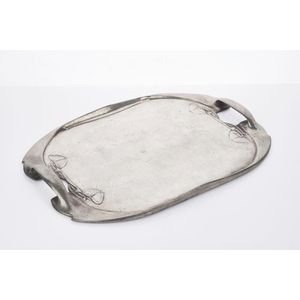
Archibald Knox Tudric Pewter Tea Service Tray, c. 1905
Archibald Knox (British, 1864-1933) for Liberty & Co., Tudric pewter tea service tray, c. 1905, twin handled, decorated with stylised tulips, length 48 cm, width 35 cm. Provenance: Private Collection, Sydney

Royal Holland Daalderop Pewter and Timber Tea Suite Jug
A Royal Holland Daalderop pewter and timber tea suite, height 31 cm jug

Jugendstil Pewter Coffee Set by Peter Behrens, Gerhardi & Co
Jugendstil pewter coffee service. Designed by Peter Behrens, Gerhardi & Co. Solingen, height 26 cm
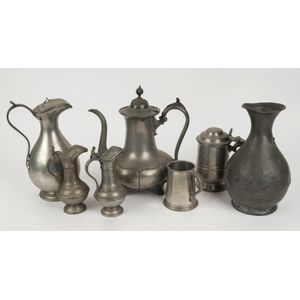
Pewter Collection from Dr. Waterhouse
Pewter teapot, jugs, tankards and vase, (7 items), the largest 24 cm high, Provenance: The Dr Douglas Frew Waterhouse collection
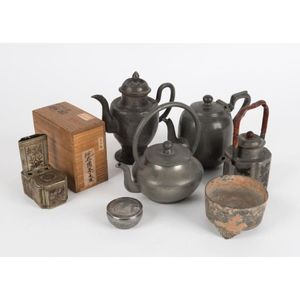
Chinese and English Pewter Tea Set and Accessories
Four Chinese and English pewter teapots, Chinese pewter tea caddy, bowl, trinket box and ink pot, 19th and 20th century, (8 items), the largest 14 cm high, Provenance: The Dr Douglas Frew Waterhouse collection
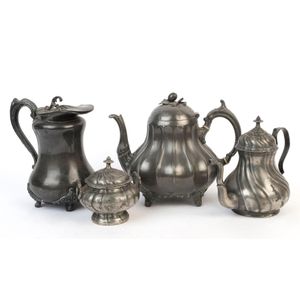
Antique 19th Century Pewter Tea Ware Set
Four pieces of antique pewter tea ware, 19th century, the largest 18 cm high
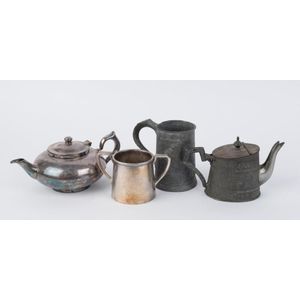
Silver Tea Set with Tankard and Sensible Teapot
Challenge 'Perfect Tea' silver plated teapot with infuser, pewter tankard, silver plated sugar basin and a Chidley's 'Sensible' teapot, 19th and 20th century, (4 items), the tankard 12 cm high
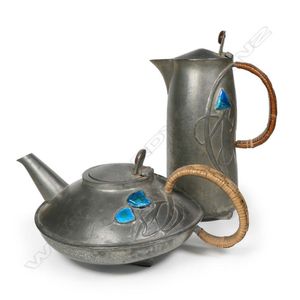
Archibald Knox Tudric Pewter Teapot & Hot Water Pots
An Archibald Knox design Tudric pewter teapot and hot water pots, #0231 with blue enamelled highlights, both with original woven cane handles and wooden thumb pieces. stamped marks.
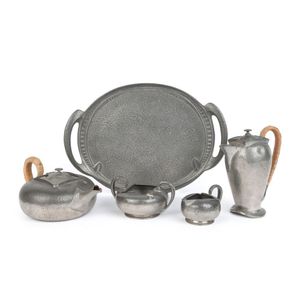
Archibald Knox Pewter Tea Set with Tray
A Liberty & Co, Tudric, pewter tea set and oval tray, designed by Archibald Knox, early 20th century, comprising a hand beaten teapot, hot water jug, sugar bowl and milk jug, plus a tray, stamped, Tudric, made in England, 17 cm high, the tray 36 x 25 cm

Art Deco Pewter Tea Service with Wooden Accents
English Art Deco 4 Pce tea pewter tea service. Tapering planished design, with wooden handles and knobs. Stamped Craftsman pewter, Sheffield, height 19.5 cm tallest

Giovanni Patrini Empire Ice Bucket
A pewter 'Portaghiaccio Impero' (Empire Ice Bucket) designed by Giovanni Patrini for Atena, 'Mesa Collection', covered urn form with liner. Stamped maker's marks. Height 52 cm

Antique Pewter Coffee Pot, 18th Century & Later
A collection of antique pewter, 18th century and later, coffee pot 28 cm high
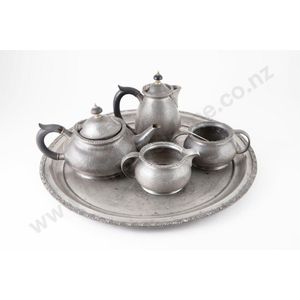
Tudric Pewter Five Piece Teaset (01075)
Five piece Tudric pewter teaset, comprising circular tray, teapot, hot water jug, milk jug and sugar bowl, design number 01075

Engraved German pewter tankard with touch marks, 1802
18th century German pewter tankard, the flat top dome lid with urn thumbpiece, engraved name and dated 1802, and 3 touch marks to the underside of the lid, 29 cm high

Asian Pottery and Metal Collection
Japanese porcelain fruit bowl, prayer wheel, three Japanese pottery tea bowls, two pottery bowls, two vases, two metal boxes, pewter egg ornament, Chinese bronze dish, Indian miniature ornament, Indian bowl, elephant pipe and pair of blue and white…

Pewter Mutation Tea Set with Timber Tray
Mutation tea set by Pascal Morabito for Etain et Prestige, in pewter with timber inset tray. Tray 28 x 19 cm
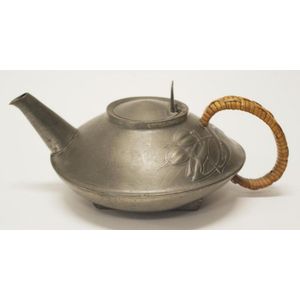
Archibald Knox Tudric Liberty Pewter Teapot #0231
Good Tudric Liberty pewter teapot Archibald Knox design, caned handle, marked to base and #0231, Reg No 420290, height 10 cm approx.

Hampden Pewter 4-Piece Beaten Tea Service Set
Four piece Hampden pewter tea service, comprising teapot, coffee pot, twin handled sugar bowl and creamer, in a beaten finish (4)

Gilt Tea Caddy with Chinese Garden Motif
A Chinese black lacquer & gilt tea caddy, the interior fitted with two pewter tea compartments & canisters, 19th century, the hinged lid painted in gilt with figures sitting & standing in an idyllic garden of foliage & pagodas, within borders of floral…

Tall Hexagonal German Pewter Tea Canister
18th century German pewter tea canister, of tall hexagonal from, with a screw cover and loop handle, height 32 cm

German Hexagonal Pewter Tea Canister with MB Inscription
18th century German pewter tea canister, of hexagonal form, with a screw cover and loop handle, inscribed MB to front, height 19 cm

19th Century Oriental Style Pottery Jugs and Teapot
A Jackfield style jug and a turned black glazed teapot, 19th century, pattern 4/3705 to jug, a straight-sided black glazed jug polychrome decorated in the oriental manner, with fancy birds and wispy foliage, with rope twist handle and hinged pewter, lid,…

Art Deco Pewter Coffee Set with Malachite Handles
A chic Art Deco style six-piece coffee set, 'Monte Carlo' by Etains du Manoir French, pewter with malachite style handles. Comprising tray, coffee pot, teapot, creamer, sugar bowl and decanter. Tallest height 24 cm

Baluster Pewter Tea Urn with Tap and Stand
19th century pewter tea urn, of baluster form, with domed cover, loop handle, tap and raised on four legs with wood feet, with later stand, a/f, height 39 cm

Archibald Knox Tudric Teaset with Rattan Handles
Archibald Knox for Liberty & Co Tudric 3 piece teaset, with raised motifs the teapot and milk jug with rattan bound handles, design number 0303
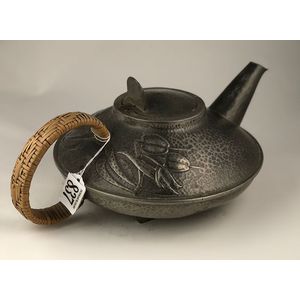
Archibald Knox's 'Tudric' Teapot with Honesty Plants
Liberty & Co 'Tudric' teapot model 0231, designed by Archibald Knox, with cast stylised honesty plants and wicker bound handle.

Tudric Hammered Coffee Set with Archibald Knox Design
An English Pewter (Tudric) three-piece coffee set, hammered finish, stamped marks including the design no. 01097, the shaped rims similar to shape 0231 designed by Archibald Knox.

Beaded Pewter Pedestal Jar with Urn Finial
Pewter pedestal jar and cover, with urn finial, with beaded surround, cylindrical body on stepped circular foot, height 20 cm

Qing Dynasty Pewter and Jade Teapot
A Chinese pewter and jade teapot, qing Dynasty, 19th century, the hexagonal waisted pot incised with auspicious lotus, bat, deity figures and script, the flat top with a small lid and a jade finial, a jade tipped straight spout and a square bracket jade…

Art Nouveau Tile Teapot Stand with Pewter Mounts
Art Nouveau teapot stand in the form of a ceramic tile with pewter mounts, 15 cm x 16 cm, a/f

Chinese Pewter Tea Set and Vase
Four items of Chinese pewter, comprising a circular tea canister, circa 1880 by Kutching, Swatow, 11 cm high, and engraved glass bottom mug, 10 cm high, a hexagonal tea pot, 9 cm high and a vase, 4 cm high
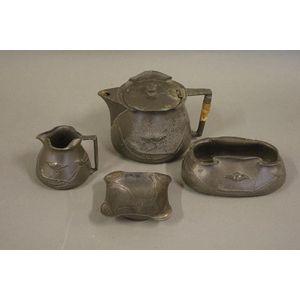
Tudric Pewter 4 Piece Teaset with Teapot, Jug, Bowl & Dish
Arts & Crafts Tudric pewter 4 piece teaset comprising of teapot (13.5 cm wide), milk jug, sugar bowl and dish, as inspected

Antique Pewter Teapot with Spaniel Finial and Invoice
Antique pewter teapot with figural 'Spaniel' finial to lid, has old 1974 invoice inside

Chinese Pewter Inlaid Coconut Teapot and Bowl Set
Chinese carved coconut inlaid pewter teapot and bowl. Width 16.5 cm max

19th Century Pewter Water Urn with Cover
An antique pewter water urn and cover, 19th century, indistinct figural maker's mark, French or English, the pear-shaped body with a pair of scrolling handles and a single spout with tap, on three scrolling supports with turned boxwood feet, the domed…

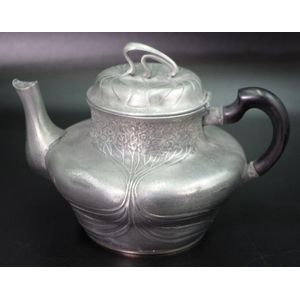

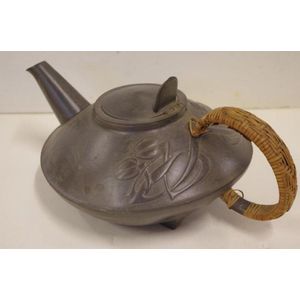
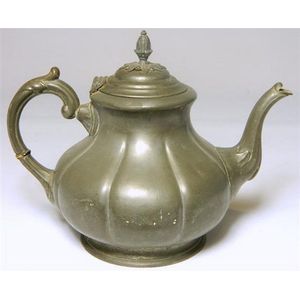
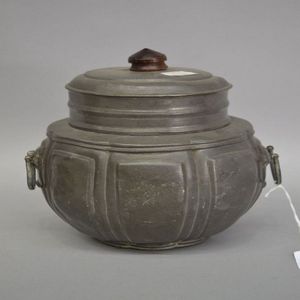

 Loading more...
Loading more...